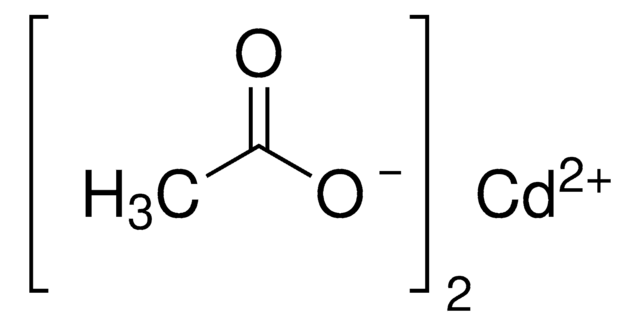Kluczowe dokumenty
202908
Cadmium chloride
99.99% trace metals basis
Synonim(y):
Cadmium dichloride, Dichlorocadmium
About This Item
Polecane produkty
klasa czystości
for analytical purposes
Poziom jakości
gęstość pary
6.3 (vs air)
ciśnienie pary
10 mmHg ( 656 °C)
Próba
99.99% trace metals basis
Formularz
solid
przydatność reakcji
reagent type: catalyst
core: cadmium
zanieczyszczenia
≤150.0 ppm Trace Metal Analysis
mp
568 °C (lit.)
rozpuszczalność
H2O: soluble 457 g/L at 20 °C (OECD Test Guideline 105)
ciąg SMILES
Cl[Cd]Cl
InChI
1S/Cd.2ClH/h;2*1H/q+2;;/p-2
Klucz InChI
YKYOUMDCQGMQQO-UHFFFAOYSA-L
Szukasz podobnych produktów? Odwiedź Przewodnik dotyczący porównywania produktów
Powiązane kategorie
Opis ogólny
Zastosowanie
- As an additive to fabricate perovskite solar cells to improve long-term stability and performance. The incorporation of Cd ions enhances optical absorption and carrier transfer.
- As a precursor to synthesize functionalized cadmium telluride quantum dots for fluorescent immunosensors.
- Aza-Michael reaction of electron-deficient alkene and a wide range of amines.
- The one-pot synthesis of dihydropyrimidones via the Biginelli reaction.
- The synthesis of benimidazoles.
Hasło ostrzegawcze
Danger
Zwroty wskazujące rodzaj zagrożenia
Zwroty wskazujące środki ostrożności
Klasyfikacja zagrożeń
Acute Tox. 2 Inhalation - Acute Tox. 3 Oral - Aquatic Acute 1 - Aquatic Chronic 1 - Carc. 1B - Muta. 1B - Repr. 1B - STOT RE 1
Kod klasy składowania
6.1A - Combustible acute toxic Cat. 1 and 2 / very toxic hazardous materials
Klasa zagrożenia wodnego (WGK)
WGK 3
Środki ochrony indywidualnej
Eyeshields, Faceshields, Gloves, type P3 (EN 143) respirator cartridges
Wykazy regulacyjne
Wykazy regulacyjne dotyczą głównie produktów chemicznych. Można w nich podawać ograniczoną liczbę informacji na temat produktów niechemicznych. Brak wpisu oznacza, że żaden ze składników nie znajduje się w wykazie. Użytkownik odpowiada za zagwarantowanie bezpiecznego i zgodnego z prawem stosowania produktu.
EU REACH SVHC Candidate List
EU REACH Annex XVII (Restriction List)
Wybierz jedną z najnowszych wersji:
Masz już ten produkt?
Dokumenty związane z niedawno zakupionymi produktami zostały zamieszczone w Bibliotece dokumentów.
Klienci oglądali również te produkty
Produkty
From Form to Function: Molding Porous Materials in Three Dimensions by Colloidal Crystal Templating
Colloidal quantum dots (CQDs) are semiconducting crystals of only a few nanometers (ca. 2–12 nm) coated with ligand/surfactant molecules to help prevent agglomeration.
Global Trade Item Number
| SKU | GTIN |
|---|---|
| 202908-10G | 4061838765376 |
| 202908-250G | |
| 202908-50G | 4061838765383 |
Nasz zespół naukowców ma doświadczenie we wszystkich obszarach badań, w tym w naukach przyrodniczych, materiałoznawstwie, syntezie chemicznej, chromatografii, analityce i wielu innych dziedzinach.
Skontaktuj się z zespołem ds. pomocy technicznej










